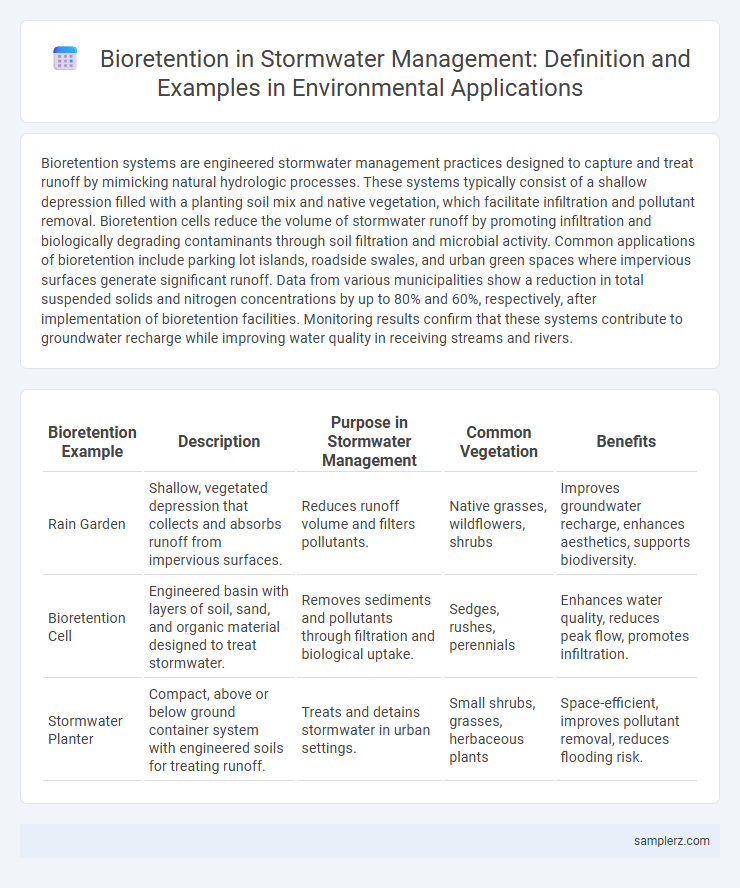Bioretention systems are engineered stormwater management practices designed to capture and treat runoff by mimicking natural hydrologic processes. These systems typically consist of a shallow depression filled with a planting soil mix and native vegetation, which facilitate infiltration and pollutant removal. Bioretention cells reduce the volume of stormwater runoff by promoting infiltration and biologically degrading contaminants through soil filtration and microbial activity. Common applications of bioretention include parking lot islands, roadside swales, and urban green spaces where impervious surfaces generate significant runoff. Data from various municipalities show a reduction in total suspended solids and nitrogen concentrations by up to 80% and 60%, respectively, after implementation of bioretention facilities. Monitoring results confirm that these systems contribute to groundwater recharge while improving water quality in receiving streams and rivers.
Table of Comparison
| Bioretention Example | Description | Purpose in Stormwater Management | Common Vegetation | Benefits |
|---|---|---|---|---|
| Rain Garden | Shallow, vegetated depression that collects and absorbs runoff from impervious surfaces. | Reduces runoff volume and filters pollutants. | Native grasses, wildflowers, shrubs | Improves groundwater recharge, enhances aesthetics, supports biodiversity. |
| Bioretention Cell | Engineered basin with layers of soil, sand, and organic material designed to treat stormwater. | Removes sediments and pollutants through filtration and biological uptake. | Sedges, rushes, perennials | Enhances water quality, reduces peak flow, promotes infiltration. |
| Stormwater Planter | Compact, above or below ground container system with engineered soils for treating runoff. | Treats and detains stormwater in urban settings. | Small shrubs, grasses, herbaceous plants | Space-efficient, improves pollutant removal, reduces flooding risk. |
Introduction to Bioretention in Stormwater Management
Bioretention is a sustainable stormwater management technique that uses engineered soil and vegetation to capture, filter, and infiltrate runoff, effectively reducing pollutants and managing stormwater volume. Commonly implemented in urban landscapes such as parking lots, streetscapes, and residential areas, bioretention systems enhance groundwater recharge while mitigating flooding risks. These systems mimic natural hydrological processes by promoting infiltration and evapotranspiration, making them a vital component in green infrastructure and low-impact development strategies.
Key Principles of Bioretention Systems
Bioretention systems rely on key principles such as infiltration, filtration, and biological uptake to effectively manage stormwater runoff. These systems utilize engineered soil media and vegetation to remove pollutants, reduce peak flow rates, and promote groundwater recharge. Proper design ensures optimal hydraulic loading rates, media composition, and plant selection to enhance contaminant removal and system longevity.
Common Bioretention Design Features
Common bioretention design features in stormwater management include a vegetated surface layer with native plants to enhance infiltration and pollutant removal. Below this, engineered layers such as a sandy soil media provide filtration, while an underdrain system ensures proper drainage and prevents waterlogging. These components work synergistically to reduce runoff volume, improve water quality, and promote groundwater recharge.
Types of Bioretention Practices
Bioretention practices in stormwater management include rain gardens, vegetated swales, and bioretention cells, each designed to filter pollutants and reduce runoff volume. Rain gardens use shallow depressions with native plants to capture stormwater, while vegetated swales channel water through vegetation that slows flow and promotes infiltration. Bioretention cells combine engineered soil media and vegetation to treat and store stormwater before it reaches waterways, improving water quality and managing urban runoff effectively.
Residential Bioretention Examples
Residential bioretention systems, such as rain gardens and vegetated swales, effectively reduce stormwater runoff by capturing and filtering rainwater from roofs and driveways. These installations promote groundwater recharge and reduce pollutants like nitrogen, phosphorus, and heavy metals entering local waterways. Homeowners in suburban neighborhoods benefit from enhanced water quality and decreased flood risks through strategically placed native plants and engineered soil layers in their bioretention setups.
Commercial Bioretention Applications
Commercial bioretention applications effectively reduce stormwater runoff and improve water quality by utilizing engineered soil media and native vegetation to filter pollutants. These systems are commonly integrated into parking lots, shopping centers, and office parks to capture and treat runoff directly on-site, preventing pollutants from entering municipal storm drains. Studies indicate bioretention cells in commercial settings can reduce total suspended solids by up to 80%, making them a sustainable solution for urban stormwater management.
Urban Streetscape Bioretention Installations
Urban streetscape bioretention installations effectively manage stormwater runoff by capturing and filtering rainwater through engineered soil and vegetation layers. These systems reduce pollutant loads, such as heavy metals and nutrients, improving water quality before it reaches natural waterways. Integrating bioretention cells into sidewalks and medians enhances urban green infrastructure while mitigating flooding in densely built environments.
Case Studies of Successful Bioretention Projects
The City of Portland's Tanner Springs Park showcases an effective bioretention system designed to capture and treat urban stormwater, significantly reducing runoff pollution through native plant filtration. Similarly, Melbourne's Street Scape Bioretention project demonstrates enhanced stormwater quality improvement by integrating bioretention cells within urban green spaces, resulting in reduced peak flow and enhanced groundwater recharge. These case studies exemplify how bioretention systems contribute to sustainable stormwater management by improving water quality and mitigating urban flooding.
Benefits and Effectiveness of Bioretention Techniques
Bioretention techniques effectively reduce stormwater runoff by promoting infiltration, filtration, and evapotranspiration, which significantly decrease pollutants such as sediment, nitrogen, and phosphorus. These systems enhance groundwater recharge, mitigate urban flooding, and improve water quality, contributing to healthier aquatic ecosystems. Research shows bioretention cells can remove up to 80% of total suspended solids and reduce peak runoff by 40-60%, making them a sustainable solution in urban stormwater management.
Challenges and Best Practices in Bioretention Maintenance
Bioretention systems face challenges such as sediment accumulation, clogging, and vegetation die-off that can reduce stormwater infiltration and pollutant removal efficiency. Best practices in bioretention maintenance include regular sediment removal, inspecting and replacing damaged plants, and ensuring proper mulch thickness to maintain soil moisture and microbial activity. Routine monitoring and adaptive management are essential to sustain system performance and enhance long-term stormwater management effectiveness.

example of bioretention in stormwater management Infographic
 samplerz.com
samplerz.com